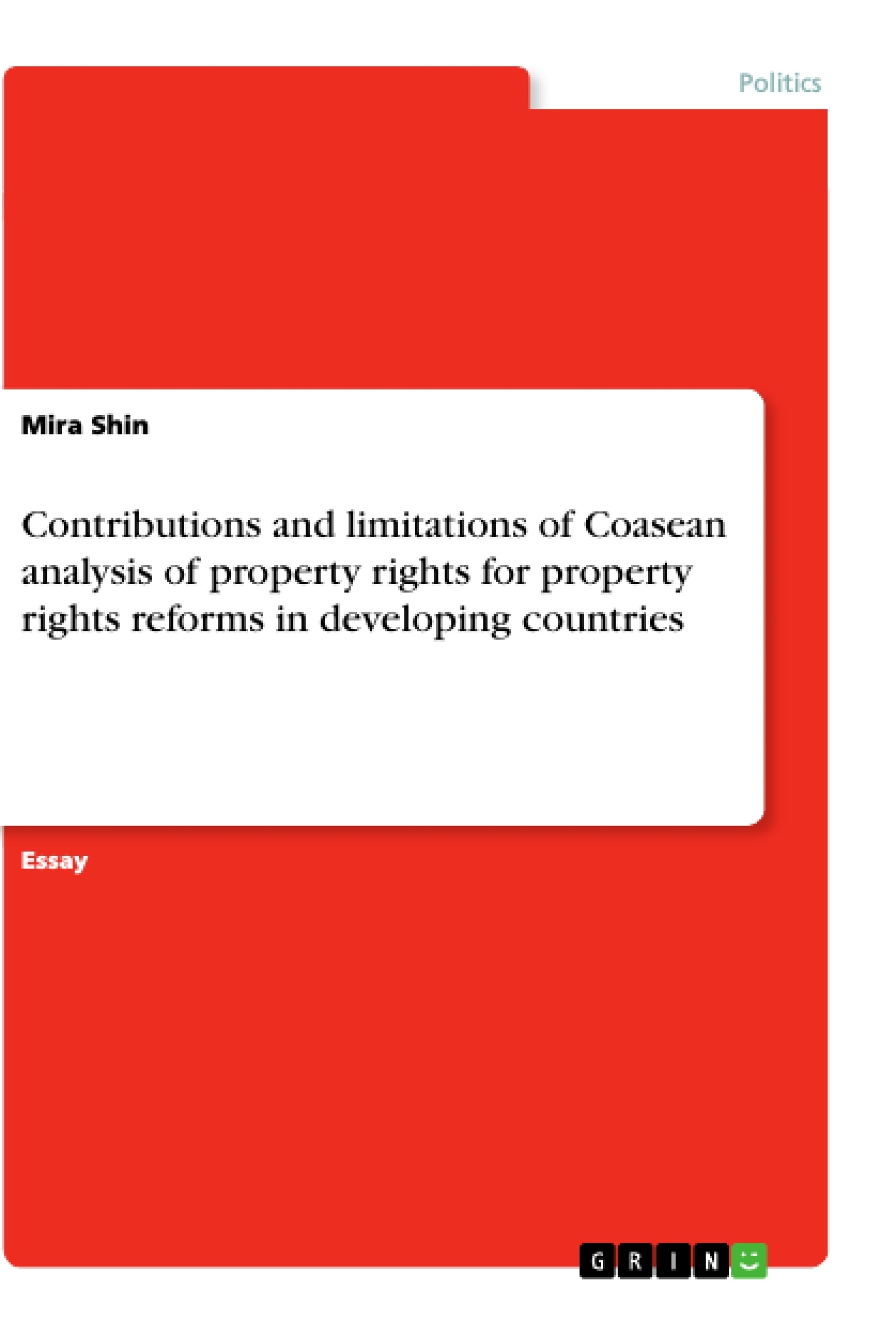Excerpt
Contributionsand limitations of Coase’s analysis of property rights for property rights reforms in developing countries
1. Introduction
The Coase Theorem on property rights was awarded the Nobel Prize in Economics in 1991. However, at the same time, over the last decades it has come under criticism from scholars (Schlafly 2007). The theorem proposed by Coase in his articleThe problem of Social Cost(1960) contributes to frame the analysis of property rights relating to transaction costs within economic discourse. Furthermore, his analysis of property rights greatly influenced new institutional economy (NIE) analysis later on. Nonetheless, Coase’s analysis of property rights is limited in its application of the analysis of property rights reforms in developing countries for several reasons.
This essay will attempt to discuss the contributions and limitations of the Coase Theorem on property rights, respectively. Firstly, what Coase’s analysis of property rights contributes will be shown based on his classic articles,The problem of Social Cost(1960) andThe nature of The Firm(1937). Following this, the limitations of Coase’s analysis of property rights will be discussed through Khan’s heterodox approaches to property rights reform analysis in developing countries.
2. Contributions of the Coase Theorem on property rights
The most important contribution of Coase’s analysis of property rights is his insightful formulation of the connection that occurs between property rights and transaction costs. In his classic article,The Problem of Social Cost(1960), Coase’s essential arguments on property rights became recognised as the Coase Theorem. Coase’s analysis started with his article,The Nature of The Firm(1937), and, in further analyses, the author went on to
explore the effects of transaction costs in relation to property rights’ distribution. Here,
property rights are the sum of legislation, rules, socio-cultural norms and organisations that create behavioural incentives (Allen 2000:893).
What the Coase Theorem explains in his classic articleThe Problem of Social Cost(1960) is that when there are no transaction costs, the most efficient economic outcome is independent from which party would otherwise appeal to property rights. Coase (1960) adds that clearly stated property rights leave room for re-distribution of assets and liabilities as agreed upon by the affected parties, leading to optimal net social benefit. That is, within Coase Theorem, property rights seek to efficient exchange which enables efficient allocations of assets, reducing transaction costs: collecting information, coming to agreed- upon rules, and their subsequent compliance (Khan 2009:35). For example, because the market is an indicative of social costs and benefits, net social benefits are optimised by redistribution if property rights can be traded with negligible transaction costs. (Coase 1960). Coase’s essential argument (1960) is that property rights need to be assigned towards minimisation of transaction costs in order to optimise the level of social activities within economic notions, which might not always coincide with developing matters of distributive justice.
In addition, Coasean analysis is attributed to the emergence of new institutional economy (NIE) analysis later on. In fact, NIE which emphasises the significance of ensuring property rights for economic development, begin withThe Nature of The Firm(1937) by Coase. In this article, Coase initially discusses transaction costs, which is the key concept of his analysis on property rights, and attempts to explain why a large number of firms exist and under what conditions these firms emerge, since production can in theory occur with no need for organised entities (Coase 1937). What the traditional economic theory, represented by figures such as Sir Arthur Salter, dominantly argued during the time when Coase wrote
The Nature of The Firm(1937) was that contracting will always be less costly than to hire
within a firm since the market is efficient and the normal economic system is coordinated by a self-driven process of price mechanism (Coase 1937:387). However, Coase’s analysis (1937) takes into account the contexts where an entrepreneur seeks to hire people rather than to contract for each particular task.
In his analysis (1937), there are two main arguments in terms of creation of the firm and the size of a firm related to transaction costs. Firstly, Coase argues that numerous transaction costs that have emerged in the market exist since the cost of gaining a good or service through the market consists of elements beyond the economic value of the good by itself. He
notes that transaction costsȢsuch as the information costs, bargaining costs, enforcement
costs, and costs for guarding trade secretsȢare likely to be included in the market cost of purchasing goods or services. With this in mind, Coase (1937) explains that firms will
emerge when they have the capacity to manage their needs internally and can eliminate these costs.
Secondly, Coase (1937) asserts that the size of a firm, depending on the number of contractual arrangements that are internal or external to them, is a consequence of securing the most efficient equilibrium between the contrasting forces of transaction costs, overhead and bureaucracy costs. In this sense, Coase (1937) argues that a firm will tend to grow larger as long as:
- organisational costs are low and rise slowly relative to the growth of transactions managed;
- there is little chance of mistakes by the entrepreneur, and the number of mistakes remains low relative to more transactions managed;
- the price of factors of production decreases, or increases little relative to the growth
- Quote paper
- Mira Shin (Author), 2017, Contributions and limitations of Coasean analysis of property rights for property rights reforms in developing countries, Munich, GRIN Verlag, https://www.grin.com/document/452504
Publish now - it's free





![Title: Neuer Institutionalismus und der Property-Rights-Ansatz in der Wirtschaftstheorie [Seminararbeit plus Präsentation]](https://cdn.openpublishing.com/thumbnail/products/12751/medium.webp)
















Comments